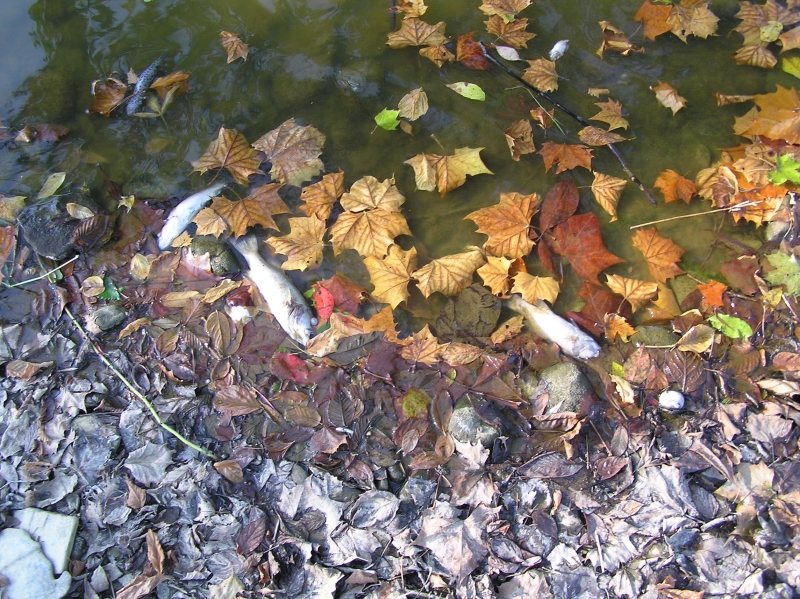
Seems to me that WV DEP is trying its hardest to mislead the public. I am a PhD biologist and algae do not produce the levels of TDS and chlorides that were found in Dunkard Creek, coincidigng with the Blacksville No. 2 outfall. See http://wvgazette.com/static/coal%20tattoo/Dunkard_EPAmemo.pdf for the data.
OK, check out the WV DEP’s own data at http://wvgazette.com/static/coal%20tattoo/WVDEP_Dunkard_Data.xls - conductivity at all of the Blacksville No. 2 outfalls were at the 5 digit range - if you believe that this is the result of an algal bloom, then I’ve got a bridge in Manhattan that you might be interested in buying! Right now WV DEP and Consol are sitting at home with their fingers crossed, hoping the citizens of WV believe this fable!
Why is that WVDEP and Tom Hoffman, CONSOL’s media flack, are the only two entities flogging the super-powered mutant algae from outer space theory? On our side of the state line, PADEP and the news media have placed the blame squarely on a massive fracking wastewater discharge. Valuable time has been wasted in an almost comical attempt to absolve CONSOL of any fiduciary responsibility in this incident. Wouldn’t time be better spent devising a plan to salvage the Dunkard Creek watershed? I don’t think lighting candles and praying to the Virgin for a miraculous healing will in any way resolve the situation.
Governor Rendell has been pressuring EPA to relieve WVDEP of its responsibility for enforcing the Clean Water Act, solely due to the fracking discharges into the Mon. They have made it apparent that they are unable or unwilling to do the job themselves.
rhmooney3 is correct. The problem is coming so many different fronts.
First, you have an ongoing conductivity/TDS/Chloride problem. The draft TMDL for the Dunkard (http://www.wvdep.org/Docs/16667_Draft_Dunkard_TMDL_Report_3_3_09.pdf) is based on data from July 2005-June 2006 and shows that the WV Fork (location of the Consol mine), South Fork WV Fork have biological impairments in part due to ionic stress (i.e., conductivity/TDS/Chloride). The 303d list (http://www.wvdep.org/Docs/16495_WV_2008_IR_Supplements_Complete_Version_EPA_Approved.pdf) shows the WV Fork, South Fork WV Fork and one trib are all listed for Chlorides. The likeliest source of this is mining. We’re just getting started!
Second, you add in the Marcellus shale gas extraction process. “I do believe that the chloride salt found in the creek in question is a result of calcium carbonate being added to mine drainage water.” This may be true, but frac water is called frac water because it dissolves halites (i.e., salts) in the strata allowing the natural gas to easily flow thru the fractures and be collected. As others have observed, this frac water is really nasty stuff and can contain a multitude of dissolved solids including heavy metals, salts, organics (an additive to the frac water) and even radioactive materials. As to whether any frac water was involved, who knows, but it would not be surprising if there were some illegal discharges (or maybe even legal) into the Dunkard.
Third, frac water needs to come from somewhere, so trucks are pumping water like crazy from the stream, thus lowering the baseflow (and yes, they do take that much water). Lower baseflow means less dilute, oxygenated water to mix with the highly saturated, low oxygen water coming from the mines and/or frac water. Now things are starting to cook!
Fourth, the Dunkard has been experiencing some low flows over the last 60 days (http://waterdata.usgs.gov/nwis/uv?cb_00065=on&cb_00060=on&cb_00095=on&format=gif_stats&period=60&site_no=03072000). Some of this could be from dewatering for frac water, but some of this could just be from a lack of rain recharging the groundwater.
And finally, we add the secret ingredient, the Golden Brown Algae. They thrive in higher conductivties and more saline water (provided by the mine outfalls 005 and 016 on the spreadsheet at http://wvgazette.com/static/coal%20tattoo/WVDEP_Dunkard_Data.xls). And a quick search of the internet shows that Texas has problems with fish kills from Golden Brown Algae (http://www.tpwd.state.tx.us/landwater/water/environconcerns/hab/ga/status.phtml), Oklahoma, Arkansas, and Maryland (http://www.dnr.state.md.us/bay/hab/heterosigma_akashiwo.html) as do pond owners (http://www.bassresource.com/fish_biology/golden_algae_control.html). The Dunkard isn’t exactly a raging stream like Deckers Creek is it? It sort of just meanders along with more slow moving pools than fast areas. But what really interests me here is the Texas and Oklahoma. In the early part of the 20th century, my family had several people that were involved in the Oil/Gas industry in Texas and Oklahoma. Because of this boom, a lot of Oil and Gas companies are headquartered there. They have lots of equipment based there. I bet some of that equipment has been transported up here for drilling. I wonder how well they clean the equipment. All it would take is one viable cell and the right conditions.
As far as the Mon TDS problems, how come the PA DEP and Governor Rendell were allowing frac water from the Susquehanna basin to be shipped over I-70 for disposal at several waste water treatment plants (which are not equipped to lower the TDS, conductivity, chlorides, etc. in waste water before dishcharge) along the Mon? If PA Gov Rendell and the PA DEP are so great, how come they were allowing this? I don’t think WV allowed such disposal at the time specifically because they were not equipped to do so. So I wonder where some of the WV frac water went during that time? WVDEP has certainly dropped the ball when it comes to allowing the amount of Chlorides in the Dunkard, but don’t point all of the fingers at WV for the Mon TDS problem.